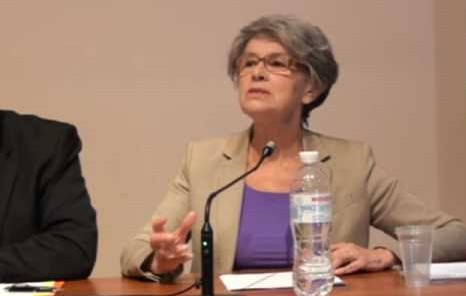
Anne-Marie Pelletier
including Brazil, Canada, Philippines, France, Germany, Italy Kenya, Syria and USA, have held the second international seminar to elaborate an “intrinsically feminine theology”. It was held at the
Urbaniana University in response to repeated invitation by Pope Francis who on several times underscored the need for a “profound theology of the woman” so that this field would not be deprived of the female prospective. Last year’s theme was
Heart and this year’s,
Tears. Are heart and tears purely feminine qualities? Tears are a gift given to everyone, women and men alike. Jesus himself wept over the death of his dear friend Lazarus. The presentations brought out the feminine manner – “far from stereotyped suffering” – of facing up to “unhappiness and desperation and of introducing into hell the balm of compassion or, better, consolation,” stated
Anne-Marie Pelletier. Her words silhouetted the figure of
Zabel Essayan, the Armenian woman from the late 1800s, graduate of Sorbonne University and well known in literary circles of the Turkish capital at the beginning of the 1900s. She went to Cilicia as a member of the Red Cross, tasked by the Armenian Patriarchate to investigate the atrocities that were perpetrated, as well as to organize assistance for the countless orphans who were wondering with a few elderly survivors among the ruins of Adana. With her eyes washed in tears, she was able to “see” clearly the abysmal sorrow and unhappiness and, through the eyes of the survivors who had gone mad from the horror, she managed to restore the story of the dead, which the assassins had meant to obliterate. “What could we give in front of that misery as vast as the ocean?, asks Zabel. There is no room for consolation in Adana, but only for compassion. In history, in the life of the world, there are also places that are inconsolable.” But another figure closer to us in time also stood out in the French theologian’s presentation:
Etty Hillesum. She also wished to accompany the tragic journey of her own people, not out of some desire for sacrifice or altruism, but because of the awareness of the history into which she was inserted and from which she had to accept the challenges. Etty feels powerless, but continues to believe that life, in spite of it all, is good, beautiful and should be listened to without ever letting oneself be overcome by the evidence of evil. In her looms the concern for others, an altruism accompanied by gestures of compassion and solidarity. Even when the other is God: “If God ceases to help me, it will be up to me to help God. He himself demands to be consoled.” A great personality from the Brazilian culture,
Maria Clara Lucchetti Bingemer, emerged from the extraordinary beauty of the Atacama Desert in Chile where archeologists and astronomers explore the mysteries of nature and the traces of history. But it is also where the
Mujeres de Calama, women have searched for the remains of their loved ones that were tortured and killed during the military dictatorship that governed the country from 1973 for 16 long years. The desert – unique in the world for its climactic conditions – conserved those bodies and, thanks to these unrelenting women, is restoring them to our feelings and to history. Also
Argentina, with its thirty six million missing persons, sees women as protagonists. They are the ones that played a fundamental role in destabalizing the pitiless military dictatorship. They were called
Las locas, the crazy women when, in 1977, they began to walk in circles in front of the
Casa Rosada capital building, to weep over their dead children. Over time they came to be known as the
Madres de la Plaza de Mayo, the mothers of May Plaza. They have come up with powerful symbols, such as the white kerchief they wear on their heads, as well as a “pacifist” but unending battle. Other women have joined them, spiritual mothers, nuns, several of whom paid with their own lives in the struggle against the dictatorship. “What is the secret to the extraordinary fruitfulness of
Chiara Lubich, who gave birth to a work so vast and universal, in just a few short years? How was she able to make any inroads inside a pre-Vatican and Italian Church, and resist with a model of the Christian life that provoked suspicion in many because of the way it engaged people from all states of life, lay people and Religious, men and women? The secret lies in what Chiara Lubich referred to as
Jesus crucified and forsaken.” This is how
Florence Gillet begins her presentation on
Jesus Forsaken in the Thought and Experience of Chiara Lubich.” Gillet was followed by a touching experience by Syrian, Mirvet Kelli. In her union with Jesus Forsaken, she was able to find the strength to stand by the Iraqi people during the years of the war. The absolute novelty and powerful impact of this basic point of the spirituality of unity really emerged in the small-group meetings.
Maria Rita Cerimele
Source: Città Nuova


0 Comments